Turning of the fagus in Tasmania
A spectacle of nature in autumn / the fall
Let us introduce you to fagus, and its fascinating survival through aeons
What is fagus?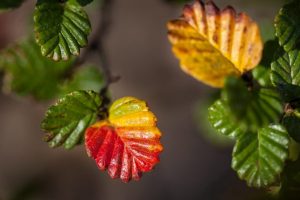
Fagus is a tree; a deciduous beech tree. It is one of Tasmania’s endemic plant species and is Australia’s only cold-climate native deciduous tree. It is also a living fossil; a relic of the Gondwana era and member of the genus of southern beeches, of which there are three species in Australia. Although, two species in Australia are evergreen, not deciduous.
Fagus is a slow-growing tree that reaches heights of between two and three metres. In saying this, its size varies according to the altitude of individual sites – for instance, it appears more like a shrub at higher altitudes.
What’s in a name?
The botanical name Nothofagus gunnii (N. gunnii) is latin… ‘nothus’ means ‘false, and ‘fagus’ means ‘beech’. So, it’s like a beech but not. The name ‘gunnii’ honours Ronald Campbell Gunn, the first to collect a specimen of the tree in 1847.
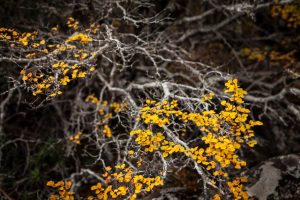 Other names and an appropriate nickname
Other names and an appropriate nickname
The most common name for N. gunnii is ‘fagus’. It also has a deserving nickname of ‘tanglefoot’. This refers to its gnarly and twisted branches that grow close to the ground and hug surrounding rocks and boulders – indeed, a trip hazard for bushwalkers.
Where it all began (mya = million years ago)
The origins of this unique plant have been traced back 100 million years! It was at this time that the first southern beech plant genus, known as Nothofagus, evolved. Fossils reveal the existence of a wide distribution of N. gunnii across Tasmania around 35mya. At that time, Tasmania was positioned further south of its present-day position and experienced long periods of winter darkness. Without adequate sunlight to harness energy for growth, plants would simply adapt to survive the winter season by entering a phase of dormancy by dropping their leaves to conserve energy.
Fagus habitat
This species of fagus (N. gunnii) grows in alpine and sub-alpine regions of Tasmania. Fagus is found in areas above 800m where winter temperatures are low, and rainfall is high (above 1800mm annually) and is not fire tolerant in any way. If fire was to reach its cool mountain habitat, it a plant that simply would not regenerate. It risks dying off forever! The habitat is also shared other sensitive vegetation, like pandani, cushion plants, snow gums and a diversity of other unique Tasmanian plants. In all of Tasmania’s 6.8 million hectares, only around 10,000 hectares (0.15%) is fagus habitat.
What we see today
Fortunately for us, this species of fagus has retained its survival tactic of past eras. In autumn each year, all its foliage falls to the ground, leaving the branches bare over winter. But first, the leaves turn from a lush green to different hues of yellow, orange and (sometimes) red. Only if we are super-lucky do we catch a glimpse of the rusty red hues, because that leaf colour is not seen every year. Trees remain dormant throughout winter and until spring. Spring is of course when the weather warms up and green foliage returns for another season.
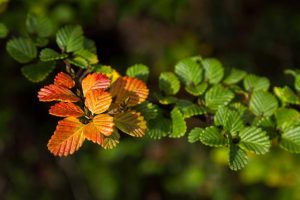 Anticipating the turning of the fagus
Anticipating the turning of the fagus
The turning of the fagus depends on sub-alpine conditions and the whim of Mother Nature. We generally anticipate the ‘turn’ to start any time from the beginning of April with the best of it lasting around two to three weeks before all the leaves have fallen. Suffice to say, there is only a small window of opportunity to see the spectacular autumn colours during this time. The most splendid and colourful display appears around the 25th April each year, an annual Australian public holiday known as ANZAC Day.
Seasonal variations
Factors like ability to photosynthesise, onset of colder weather along with strong winds, autumn rains and/or snow influence when, where and how long the turning of the fagus can be seen.
Why fagus most admired in autumn/the fall
The vibrant colour change of fagus foliage is truly captivating in autumn/the fall. The landscape is ‘painted’ with stunning autumnal hues which accentuates the many patterns, textures and colours of the foliage. And it’s for this reason that nature and photo-enthusiasts admire it during this time. From spring through to autumn, the plant has green foliage which, without an understanding of the habitat, is not as easily spotted from a distance.
Our passion and profession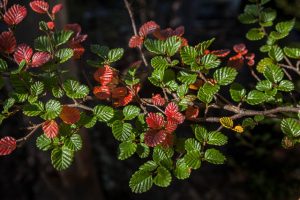
We eagerly anticipate the autumnal turning of the fagus each year, not only for ourselves but to stay informed on behalf of our tour guests too. Outside of leading tours, we aim to trek into the mountain landscape and photograph the ever-changing vibrant landscape. Each time we spend a significant amount of time seeking out a different perspectives like new and interesting patterns, textures and compositions. We search for the elusive red leaves too, which do not appear every year.

Quick facts about
Nothofagus gunnii
- A living fossil with links to the Gondwana era
- Tasmania’s only native deciduous tree
- An endemic species only found in Tasmania
- Found in areas above 800m where rainfall is high
- A rare plant with habitat in only 0.15% of Tasmania’s land mass
- Very slow growing, reaching not much more than 2 meters (6-7ft);
- Survival would be threatened if fire reaches habitat
- Its nickname is ‘tanglefoot’

Our fagus findings
- 2023 – Roy visited Mt Field on the 25th April. Plenty of yellow Fagus leaves around, although no red Fagus leaves seen by him this year. Some leaves were finished for the season and already falling off the branches.
- 2022 – having not seen the beginning ourselves, we believe the first hint of the ‘turning of the Fagus’ was around mid-April with still a splattered splash of golden hues still to be seen on 11th May. Coreena was out and about in the final stages of the season. View a short video about her trek into Fagus habitat in May 2022
- 2021 – the season came and went without an opportunity for us to visit the regions in which it grows.
- 2020 – the ‘turning of the Fagus’ will occur in isolation. However, there’ll be no seeing it with our own eyes due to enforced travel restrictions and national park closures during the coronavirus lockdown.
- 2019 – first signs of the turn came in around mid-April. Some foliage hung on into early May. But strong winds would have meant the trees will have become bare soon after.
- 2018 – at higher altitudes signs of colour were seen in the first week of April. Still plenty of colour in different areas on 25th April/ANZAC Day.
- 2017 – some areas saw colour changing around the 2nd week of April with the more vibrant yellows starting to appear in around mid-April.
- 2016 – Like 2015, the turn started happening late in March/early April. We began to wonder if a new natural trend was starting. High winds throughout Tasmania during the season meant that by the time 25th April/ANZAC Day came around, the colourful foliage was all but gone with very little left to see.
- 2015 – An earlier than ‘normal’ season with colour changing at the beginning of April. By the beginning of May, the season had all but ended in the higher altitudes of the Tarn Shelf in Mt Field National Park, with most leaves fallen to the ground. But at the same time, Fagus around Lake Fenton (lower altitude), a golden colour blazed the landscape for a little while longer. This blog post was published in this year
Go to Tasmania Parks and Wildlife Service Tasmania website for more about plant diversity in Tasmania


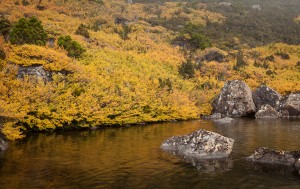




Excellent piece on a very interesting tree. I am intrigued by the Fagus and I want to see and learn more. I am particularly interested in the array of colours the Fagus takes on through the seasons.
Thank you Chris. We’re pleased that you enjoyed reading about it – it sure is a fascinating part of Tasmania’s natural environment.